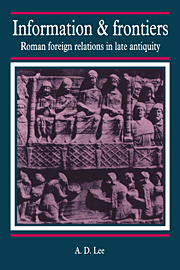Book contents
- Frontmatter
- Contents
- Preface
- Chronological list of selected Roman emperors (early third to early seventh century)
- Chronological list of Sasanian kings (220s–628)
- Map 1 The Middle East in late antiquity
- Map 2 Northern Mesopotamia and adjacent regions
- Map 3 The middle and lower Danube and adjacent regions
- Map 4 The Rhine and upper Danube and adjacent regions
- List of abbreviations
- Introduction
- PART I CONTEXTS
- 1 The protagonists
- 2 At the interface: the frontier regions
- PART II INFORMATION AND UNCERTAINTY
- PART III SOURCES OF INFORMATION
- Select bibliography
- Index of sources
- General index
2 - At the interface: the frontier regions
Published online by Cambridge University Press: 29 September 2009
- Frontmatter
- Contents
- Preface
- Chronological list of selected Roman emperors (early third to early seventh century)
- Chronological list of Sasanian kings (220s–628)
- Map 1 The Middle East in late antiquity
- Map 2 Northern Mesopotamia and adjacent regions
- Map 3 The middle and lower Danube and adjacent regions
- Map 4 The Rhine and upper Danube and adjacent regions
- List of abbreviations
- Introduction
- PART I CONTEXTS
- 1 The protagonists
- 2 At the interface: the frontier regions
- PART II INFORMATION AND UNCERTAINTY
- PART III SOURCES OF INFORMATION
- Select bibliography
- Index of sources
- General index
Summary
no treatment of late Roman foreign relations would be complete without some consideration of the frontier regions within which those relations were played out. In the case of this study, however, an investigation of the relevant frontier regions is especially vital because their character exercised an important influence on the availability of information. The Roman empire as a whole encompassed considerable diversity, both environmentally and culturally, and this is particularly apparent in the contrasts between the frontier region shared with Persia in the east, and that (or rather those) along the northern bounds of the empire. These differences form the focus of this chapter; their full significance will become apparent at a later stage (see Chapter 5).
THE EAST
The formal political boundary between the Roman and Persian empires was subject to some variation during the course of late antiquity, but apart from a brief period in the early seventh century, the southern half of its course always lay within the open region of northern Mesopotamia. The northern half of the boundary proceeded across the mountainous territory which lay between the Taurus range and the Black Sea, though the existence of the kingdom of Armenia during parts of the first century and a half of Roman–Persian relations meant that the two empires did not always have a common boundary in this area.
- Type
- Chapter
- Information
- Information and FrontiersRoman Foreign Relations in Late Antiquity, pp. 49 - 78Publisher: Cambridge University PressPrint publication year: 1993

